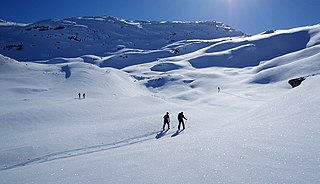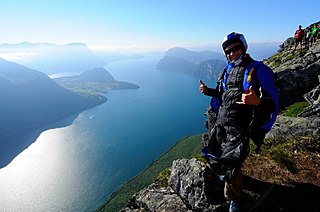
Cross-country skiing is a form of skiing whereby skiers traverse snow-covered terrain without use of ski lifts or other assistance. Cross-country skiing is widely practiced as a sport and recreational activity; however, some still use it as a means of travel. Variants of cross-country skiing are adapted to a range of terrain which spans unimproved, sometimes mountainous terrain to groomed courses that are specifically designed for the sport.

Alpine skiing, or downhill skiing, is the pastime of sliding down snow-covered slopes on skis with fixed-heel bindings, unlike other types of skiing, which use skis with free-heel bindings. Whether for recreation or for sport, it is typically practiced at ski resorts, which provide such services as ski lifts, artificial snow making, snow grooming, restaurants, and ski patrol.

Telemark skiing is a skiing technique that combines elements of Alpine and Nordic skiing, using the rear foot to keep balance while pushing on the front foot to create a carving turn on downhill skis with toe-only bindings. Telemark skiing is named after the Telemark region of Norway, where the discipline originated. Sondre Norheim is often credited for first demonstrating the turn in ski races, which included cross country, slalom, and jumping, in Norway around 1868. Sondre Norheim also experimented with ski and binding design, introducing side cuts to skis and heel bindings.

Ski mountaineering is a skiing discipline that involves climbing mountains either on skis or carrying them, depending on the steepness of the ascent, and then descending on skis. There are two major categories of equipment used: free-heel Telemark skis and skis based on Alpine skis, where the heel is free for ascents, but is fixed during descent. The discipline may be practiced recreationally or as a competitive sport.

Tuckerman Ravine is a glacial cirque sloping eastward on the southeast face of Mt. Washington, in the White Mountains of New Hampshire. Although it draws hikers throughout the year, and skiers throughout the winter, it is best known for the many "spring skiers" who ascend it on foot and ski down the steep slope from early April into July. In this period, the temperatures are relatively mild but the natural snowpack — which averages up to 55 feet (17 m) in a typical winter — is still adequate to ski most seasons. The record-setting high winds atop Mount Washington scour a massive amount of snow from the surrounding highlands and drop it here or in the adjacent Huntington Ravine.

Aspen Highlands is a skiing mountain in Aspen, Colorado. It is famous for the Highland Bowl, which provides what some people consider some of the most intense, wild, and fun skiing in the state. The Aspen Skiing Company operates Aspen Highlands.

Freeskiing, or new school skiing, is a specific type of alpine skiing, which involves tricks, jumps, and terrain park features, such as rails, boxes, jibs, or other obstacles. This form of skiing resulted from the growth of snowboarding combined with the progression of freestyle skiing. "Newschoolers", or those who specifically ski in this style, as opposed to traditional freestylers, freeriders, big mountain skiers, and racers, are often found in terrain parks, which are designed specifically for tricks.

Heli-skiing is off-trail, downhill skiing or snowboarding where the skier reaches the top of the mountain by helicopter, instead of a ski lift.

Para-alpine skiing is an adaptation of alpine skiing for athletes with a disability. The sport evolved from the efforts of disabled veterans in Germany and Austria during and after the Second World War. The sport is governed by the International Paralympic Committee Sports Committee. The primary equipment used includes outrigger skis, sit-skis, and mono-skis. Para-alpine skiing disciplines include the downhill, super-G, giant slalom, slalom, super combined, and snowboard.
William Morse Briggs is notable as the first to ski the Grand Teton on June 15, 1971, and as a result is said to be the "father of extreme skiing" in North America. He is the director of the Great American Ski School, formerly located at Snow King Mountain in Jackson, Wyoming in the United States.
Doug Coombs was an American alpine skier and mountaineer who helped to pioneer the sport of extreme skiing, both in North America and worldwide.

Shane McConkey was a professional skier and BASE jumper. He was born in Vancouver, British Columbia and eventually based himself in Olympic Valley, California. Due to an itinerant childhood, he never identified with a single place, but he was said to have come from Boulder, Colorado. It was from here that he started his professional skiing career. He did so after dropping out of the University of Colorado Boulder to pursue his dreams.
Patrick Vallençant was a French alpinist/skier and pioneer in ski mountaineering.

Sylvain Saudan was a Swiss extreme skier, dubbed "skier of the impossible." He was noted for skiing down large and steep mountains, including those in the Himalayas, North America, Asia, Africa, and Europe. In 1982, he entered the Guinness Book of World Records for descending the highest and steepest slope ever skied.
Steep is a 2007 documentary about extreme skiing written and directed by Mark Obenhaus. Steep explores the history of extreme and Big Mountain Skiing, starting with its roots in 1960s and 1970s North America and Europe, with Bill Briggs' now famous first descent of the Grand Teton, and progressing through to the current day sport.

Jean-Marc Boivin was a French mountaineer, extreme skier, hang glider and paraglider pilot, speleologist, BASE jumper, film maker and author. The holder of several altitude records for hang gliding and paragliding, the creator of numerous first ascents and first ski descents in the Alps, a member of the team that broke the record for a sub-glacial dive and the first person to paraglide from the summit of Mount Everest, Boivin was a pioneer of extreme sports. He died from injuries incurred after BASE jumping off Angel Falls in Venezuela, the highest waterfall in the world.

Ultimate Rush is a 2011/2012 documentary television series produced by the Red Bull Media House in association with Matchstick Productions. It is also marketed as a combination of stupendous action sports endeavour, coupled with a cinematic-approach to storytelling. Through its wide distribution in the United States, the United Kingdom, Brazil, Denmark, Austria and other territories, the series is evidence of the acceptance of extreme sports into mainstream television, and one of the most complete accounts thereof. The series focuses on the outrageous exploits of some of the best athletes in the world, and how they explore the fine line between extreme sports, philosophy and art. Most of the filming was conducted in the rugged backcountry of British Columbia, Alaska, the Rocky Mountains, the French Alps, the Himalayas and the Andes, but not at official events or secured sites.
This glossary of skiing and snowboarding terms is a list of definitions of terms and jargon used in skiing, snowboarding, and related winter sports.

Ski-BASE jumping is the recreational sport of skiing at a high speed off of a cliff or mountain and free-falling through the air, using a parachute to descend to the ground, therefore combining the two sports of skiing and BASE jumping. Participants often perform tricks or manoeuvres during the freefall and remove their skis mid-air in order to safely deploy the parachute and land.

Lauberhorn is the longest and oldest active World Cup downhill ski course in the world, which is located and named after the same name mountain in Wengen, Switzerland, debuted in 1930. As Switzerland is and always was military neutral, downhill competitions were held even during World War II.

















